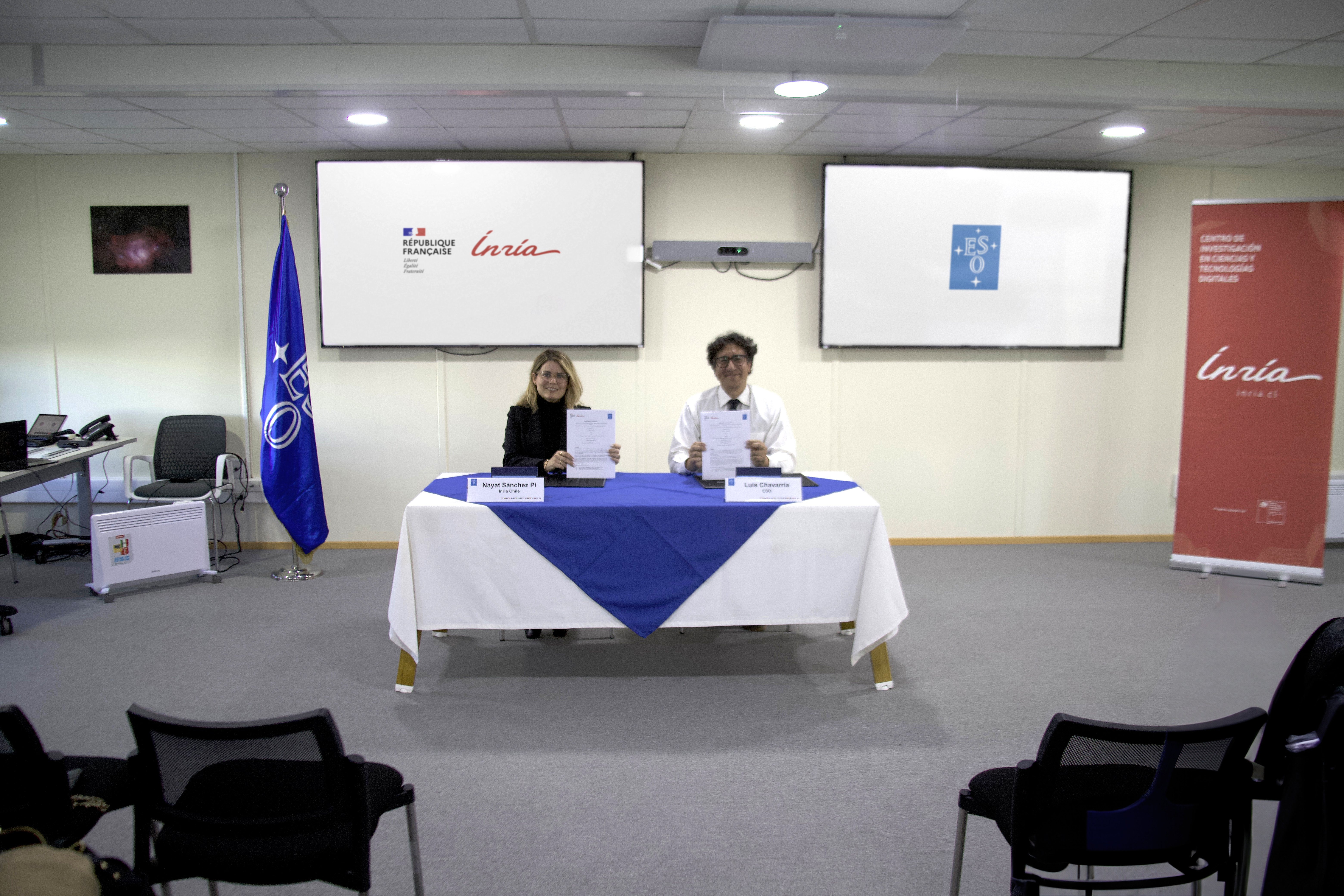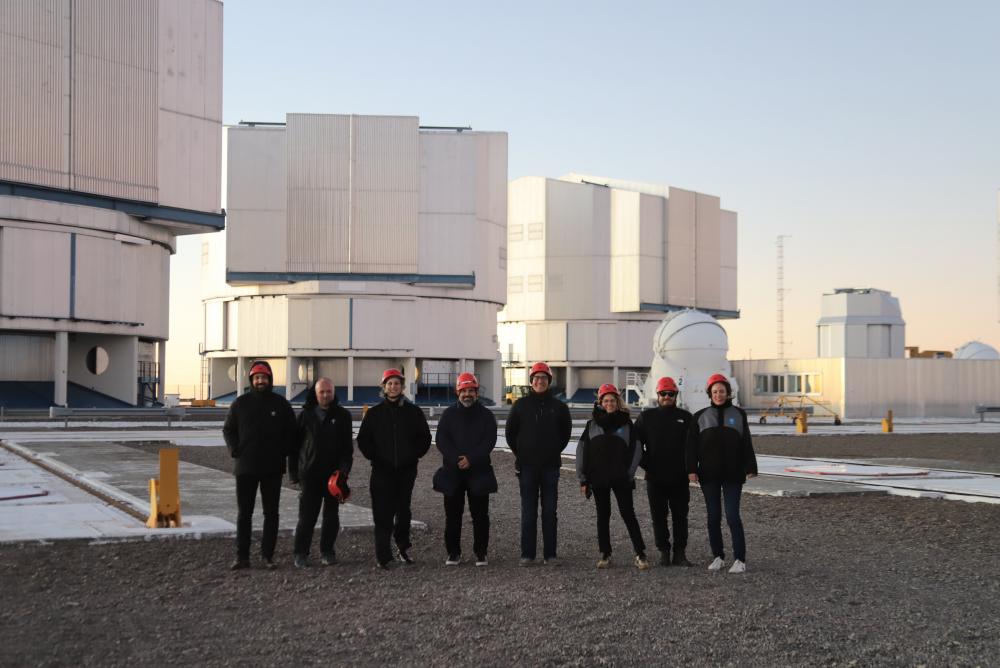
The European Southern Observatory (ESO) and the French research institute in digital sciences, Inria Chile, signed a Memorandum of Understanding on May 16 to develop the integration of the operations of two of the world's most advanced telescopes, the Very Large Telescope (VLT) and the Extremely Large Telescope (ELT), both operated by ESO at the Paranal Observatory, located in Chile, 120 km south of the city of Antofagasta, in the Atacama desert.
The agreement between ESO and Inria Chile will allow for collaboration on projects to support the digital transformation of ESO's observatories. The Memorandum was signed by Luis Chavarría, ESO's representative in Chile, and Nayat Sánchez-Pi, Inria Chile's director, with the participation of Gonzalo Arenas, head of International Relations of the Ministry of Science, Technology, Knowledge and Innovation of Chile, representing said portfolio. Together, they toured different telescopes and observed the work of the observatory's control room.
The VLT and ELT: two telescopes at the forefront of astronomy and engineering
ESO operates the Very Large Telescope (VLT) at the Paranal Observatory, the most advanced visible-light telescope in the world, and, at the end of this decade, it will put into operation the Extremely Large Telescope (ELT), the largest visible and near-infrared telescope in the world, currently under construction on Cerro Armazones. The integration of the ELT into the operations of the Paranal Observatory poses great challenges and demands constant improvements.
The Very Large Telescope (VLT) is one of the most advanced telescopes in the world, composed of four "Unit Telescopes" with 8.2-meter-diameter main mirrors and four 1.8-meter-diameter movable Auxiliary Telescopes. The telescopes can work together to form a giant 'interferometer', the ESO Very Large Telescope Interferometer, allowing astronomers to capture much finer details of the cosmos than would be possible with the Auxiliary or Unit Telescopes alone.
On the other hand, the Extremely Large Telescope (ELT), a project still under construction, has a 39-meter main mirror and will be the largest visible and infrared telescope in the world, considered the 'world's largest eye in the sky'. Since 2005, ESO has worked with its community and industry to develop this extremely large optical/infrared telescope. In addition to its unparalleled size, the ELT will be equipped with a range of cutting-edge instruments designed to cover a wide spectrum of scientific possibilities. The ELT program was approved in 2012 and the green light was given for its construction on Cerro Armazones in the Atacama desert, Chile, at the end of 2014.
An agreement that will transform the Paranal Observatory, thanks to digital sciences and AI
With this new agreement and the union of forces between Inria Chile and ESO, an important step will be taken toward the forefront of astronomy, integrating the operations of the VLT (Very Large Telescope) and ELT (Extremely Large Telescope) telescopes through innovative solutions in artificial intelligence, data analysis, and technological infrastructure.
Inria Chile hopes to develop new technologies including integrated control systems for telescopes, tools for predictive maintenance data analysis, and platforms for monitoring critical operations. These initiatives will not only optimize current processes but also prepare the ground for the inclusion of the ELT at the end of this decade, establishing a new standard in global astronomical research.
Verbatim
ESO's ELT will be the largest optical telescope in the world, which will represent a considerable challenge. Our goal is to fully integrate it into the daily operations of Paranal. This collaboration agreement will allow us to explore the best way to achieve this and take advantage of Inria's experience in large observatories, such as ALMA, of which we are also part.
ESO Representative in Chile
Verbatim
This alliance with ESO for the operations of the ELT and VLT fills us with enthusiasm and pride, as it will allow us to push the frontier of scientific and technological knowledge in digital sciences in a key sector for Chile such as Astronomy. Our vast experience in digital sciences, artificial intelligence, and data analysis, combined with our track record of working with astronomical observatories, will be key to developing innovative digital solutions that will optimize the operations of the Paranal Observatory.
Inria Chile Director
Verbatim
We are very excited to partner with Inria to develop the future operations model for our Paranal Observatory with the VLT and ELT. Inria's vast experience in this area is crucial to our ambitious plans to operate the world's largest ground-based observatory in an efficient, effective, and sustainable manner.
ESO Director of Operations
Towards new discoveries by the Chilean and international scientific community
The ESO-Inria Chile alliance will focus on four main lines of work:
-
The creation of an integrated control system for the VLT and ELT telescopes, improving coordination and performance for more precise and efficient observations.
-
Data analysis for diagnostics and predictive maintenance, through the analysis of large volumes of data, to predict and prevent telescope failures, optimizing their functioning and reducing downtime.
-
The development of a reporting, visualization, and analysis tool that will allow scientists and technicians to visualize and analyze key points during telescope operations, facilitating decision-making and monitoring of observations.
-
The creation of an infrastructure for data, models, and experimentation, developing a platform to host the information generated by the telescopes, as well as artificial intelligence models and experimentation tools, fostering innovation and continuous improvement in astronomical research.
A review of Inria and Inria Chile's collaboration with the ALMA observatory
Before the opening of Inria's center in Santiago, Chile in 2012, the collaboration between Inria and the European Southern Observatory (ESO) had already been solid. This collaboration has particularly focused on the ALMA observatory, located in the Atacama Desert. Astronomers and antenna operators of ALMA use 14 ZVTM software tools developed by Inria to solve problems and make decisions.
The main challenge was to design interactive visualization software for operations in a complex astronomical environment. Between 2010 and 2012, the ILDA team of Inria Saclay led this initiative, subsequently managing three new projects to improve these tools. Thanks to this international collaboration, monitoring and control operation software, and the ALMA Dashboard were developed, which are used daily in the observatory's control room.
Other Inria Chile projects with ALMA include an interface for visualizing time series, software for the antenna's status, and an integrated alarm system to respond to operational events. This alarm system is potentially reusable in other astronomical complexes worldwide.
Pushing the frontier of scientific and technological knowledge
This alliance and the success of these lines of work will not only be a big step for ESO and Inria Chile but also for Chilean and international scientists who will be able to make even more significant discoveries, opening new frontiers in the understanding of the universe. This framework agreement between the European Southern Observatory (ESO) and Inria Chile represents an important advance in scientific and technological collaboration that involves France, Chile, and ESO.



